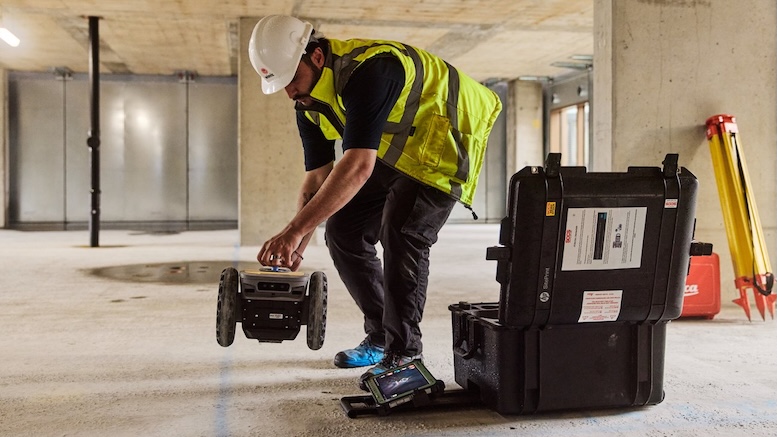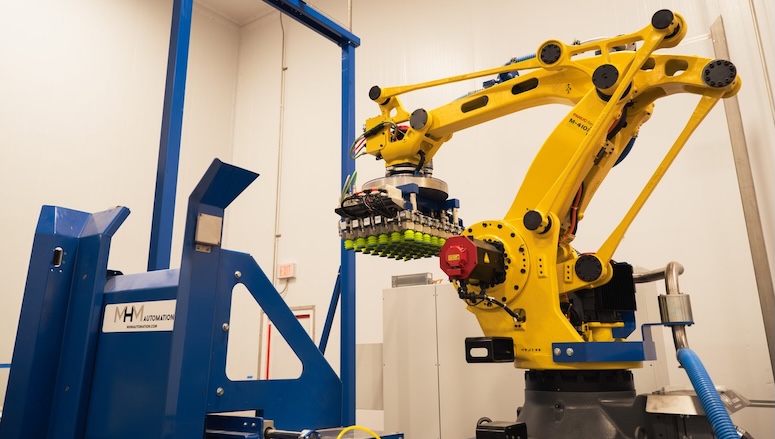— 11 min read
Building a Construction Tech Stack: A Contractor’s Guide



Last Updated Sep 23, 2025

Trevor Baggett
Construction Technology Manager
Trevor Baggett brings over a decade of industry experience to Spring Valley Construction Company (SVCC) as their first Construction Technology Manager. He specializes in integrating cutting-edge technologies into construction practices. He plays a crucial role in evaluating, implementing and updating the company's software and hardware systems, ensuring that SVCC stays at the forefront of technological advancement in both the office and field.

Steve Schultz
Business Analyst
Steve Schultz brings more than two decades of experience in construction to his current role as Business Analyst at James G. Davis Construction (DAVIS). He has also held pivotal roles at various organizations, including BF Joy, Berkeley Research Group, Olson Engineering, and Donohoe Construction Company. Not only has Steve demonstrated expertise in business development, project management, and risk analysis, but he also earned specialized certifications, including Procore's Project Manager credentials and being a Certified Aging-in-Place Specialist (CAPS). His extensive background encompasses underground infrastructure, structural health monitoring, and pre-construction services, making him a valuable asset in data analytics, claims management, and technical support in construction projects. Steve is based in the Washington D.C. area.

Julia Tell
Contributing Writer
68 articles
Julia Tell is a freelance writer covering education, construction, healthcare, and digital transformation. She holds a Ph.D. in Media & Communications and has written for publications including Business Insider, GoodRx, and EdSurge, as well as nonprofits, international businesses, and educational institutions.
Last Updated Sep 23, 2025

Every construction company uses a variety of software and technology applications: Some are purpose-built to solve a specific challenge, while others work as a platform to centralize solutions to a wide array of industry-specific needs. A tech stack is a group of software applications that work together to achieve business objectives and empower company leadership to easily view and analyze performance data.
In construction, a company’s tech stack will typically include software designed for managing construction projects, estimating costs, preparing and submitting bids, scheduling, preparing pay applications and much more. Integrating all of these various tools into a central tech stack enables companies to make full use of the data they collect through these applications, making it easier to manage and analyze.
In this article, we’ll look at how construction companies select and assess software solutions to build a tech stack and share best practices for the industry.
Table of contents
Why do contractors need a tech stack?
Contractors need a tech stack to streamline operations, improve data accuracy, and enhance communication between different departments and stakeholders.
Having an integrated tech stack allows contractors to solve specific business problems efficiently, whether it's managing financial data, scheduling, or ensuring safety compliance. The end goal is to complete projects quicker and with less money spent, improving the overall business.
Types of Software in a Construction Tech Stack
Broadly, there are two categories of software in construction:
- Business software is used to aggregate project-level data, track overall company performance and manage day-to-day operations.
- Project software is used to manage all of the activities on a construction project and track project performance.
Business Software
Much business software is industry-agnostic — for example, no one makes a word processor specifically for construction. At the same time, software companies are increasingly specializing in a particular industry to solve unique challenges and specific use cases.
Enterprise Resource Planning (ERP) System
A company’s ERP system acts as the central hub for all financial data, crucial for executive decision-making. Any software that touches financial data needs to integrate seamlessly with the ERP system.
Accounting Software
Accounting software (such as an ERP system) enables financial reporting, managing accounts payable and receivable, as well as general ledger functions.
Human Resources Software
HR software helps manage employee information, benefits, and payroll. This software needs to integrate well with accounting and ERP systems to ensure accuracy.
Office Suite Software
A variety of office suite applications — including email, word processing and spreadsheets — are used to manage day-to-day communication and business operations. These tools are essential for communication and documentation.
Project Software
Because this industry is project-based, most of these applications are tailor-made for construction. A contractor may select a standalone solution for each activity, or choose a solution that offers a suite of these tools in a single, centralized project management platform.
Preconstruction
Estimating Software
Estimating software is used to calculate the costs associated with a project, covering everything from materials to labor. The pre-construction team uses this software to project backlog and estimate future work.
Bidding Software
Bidding software helps organize bids received from subcontractors and compile them into a master bid package for the project owner. Most work is negotiated through long-standing relationships with clients, but accurate and organized bidding software is still necessary to manage this process.
Prequalification Software
Prequalification software is essential for vetting subcontractors to ensure they meet the necessary requirements and standards for a project, thereby hiring qualified professionals and mitigating risks.
Permitting Software
Permitting software helps companies apply for and track the status of building permits.
Operations
Scheduling Software
Scheduling software is vital for planning the timeline of a project. However, finding one that works well with Mac can be challenging. Currently, new scheduling software is being tested to address issues with previous systems, which often had problems like disappearing schedules.
Workforce Management Software
Workforce management software helps track labor on site and manage daily reports, ensuring accurate data on who is working and what has been accomplished each day.
Equipment Management Software
Equipment management software enables efficient scheduling and tracking of owned or leased equipment, from drills to fleet trucks to front loaders. Some companies incorporate this into their project management to ensure all materials are on site when needed.
Inventory Management Software
Inventory management software allows the company to track stock of materials and consumables, like PPE, that need to be replaced.
Financials
Contract Management Software
Contract management software organizes contractual documents and project requirements for easy access to drawings, specifications and payment information.
Project Financial Software
Project financial software enables project managers to track billings, manage costs and oversee the project budget. This software is often integrated with the main accounting system to provide real-time financial data across multiple projects.
Invoicing Software
This software manages pay applications from subcontractors and sends out pay applications to project owners, streamlining the payment process and ensuring timely payments.
Initiating New Technology Solutions
Technology isn’t a solution unto itself — it is designed to solve a problem or increase productivity. The need for new tech most often comes either from the field (bottom-up) or from the company leadership (top-down). Depending on which direction the request comes from, the approach to evaluation can differ slightly.
Bottom-Up: Field Requests
When software requests come from the field, the process typically starts with a project manager, superintendent or someone else with a specific need. The software is then evaluated internally. a group of field staff who would benefit from the solution. After identifying a use case and testing the software on one or two projects, it is presented to upper management for approval. If the software proves beneficial, it could become an enterprise-wide solution.
For example, a superintendent may request a new scheduling system that includes the ability to solicit input from subcontractors and produce look-ahead schedules.
In a previous role at the company, we implemented a reality capture solution driven by field requests. They wanted to take 360 walk-throughs of job sites to be able to see what was behind the drywall later on. For example, if there was a leak in a room, instead of ripping out the entire wall, we could go back in our app, scroll to before the drywall was installed, and see where the pipe was. This way, we might only have to rip out a foot of drywall instead of the whole wall. The field-driven solution was then brought up to the office and implemented successfully.

Trevor Baggett
Construction Technology Manager
Spring Valley Construction Company
Top-Down: Executive Requests
In the top-down approach, the process starts with identifying a problem at the executive level. These requests often stem from the desire for clearer or more accurate reporting. A CFO might want better visibility into real-time financial performance across all projects.
Once the problem is articulated, multiple software options are researched, starting with about 15 and narrowing down based on their ability to solve the problem. Demos are conducted, and the software’s integrations are tested. After further narrowing down to two or three options, a think tank with key stakeholders is formed to make a final decision. Once a software is selected, the implementation phase, including training and support, begins.
Free AI in Construction Course with Hugh Seaton
Start learning today with industry expert Hugh Seaton and discover how AI can boost efficiency, reduce risk, and transform your projects.

Best Practices for Building a Construction Tech Stack
Building a tech stack requires a conscious, intentional approach. Adding new software too quickly or without proper preparation can lead to poor performance and increased resistance to new technology.
Establish evaluation criteria.
When choosing software for a tech stack, it is helpful to establish the decision criteria that will be used to evaluate all options. Different software solutions can be plotted on a spreadsheet to compare how well each one meets the list of criteria.
Problem-Solving
Identify the specific problem the software should solve. Without a clear problem to solve, adding technology for the sake of it risks creating more issues.
Integrations
The software must integrate well with other tools in the tech stack, particularly the ERP and/or project management platform. Look for solutions with open APIs that allow for seamless data transfer and compatibility with existing systems.
Usability
The software must be user-friendly. If it's not easy to use, staff won't adopt it, and it won't be effective.
Support
Evaluate the level of support offered by the software provider. Good customer support can significantly affect the software's successful implementation and ongoing use.
Scalability
The software should be able to grow with the company and adapt to new needs as they arise.
Cost
Consider both the upfront cost and the ongoing costs of maintaining the software. Finding a solution that provides good value for the investment benefits operations and the company’s bottom line.
Battle-test potential solutions.
While the IT department is often driving the research and testing of new technology, it is important to involve the people in the field that will actually be using it. Put potential software through rigorous field tests to ensure it holds up, is easy to use, and delivers on its promises.
To evaluate usability, talk to the people using the software daily. Testing it in the office might show zero flaws, but the field may experience different issues. Understanding their needs helps customize the software for better performance or identify when a different solution is necessary.
During testing, I try to break the system to see if it will hold up in the field.

Trevor Baggett
Construction Technology Manager
Spring Valley Construction Company
Even after a solution is chosen, it can be helpful to buy a license and put it through another round of focused testing on a single project before rolling it out to the rest of the company. This allows stakeholders to see how it performs in a real-world setting and gather feedback from the team using it. Depending on whose budget the software cost goes to, it can even create a financial incentive to ensure it is adopted and adequately tested.
We have enterprise software like our project management system and accounting system that is billed as overhead to every project every month. However, new software being tested is charged to the project itself. This ensures that project managers who are truly invested in the software are more likely to pay attention and make it work.
If the software is free, people don't really share the responsibility. But once they're involved in paying for it, they start paying more attention and are more committed to making it successful.

Steve Schultz
Business Analyst
James G. Davis Construction Corp
Recruit a team.
To engage key stakeholders, many construction companies establish a tech committee that includes a mix of personalities and roles. For instance, in an operations project, the VP of Operations, the most tech-savvy project manager, the most resistant-to-change project manager, an assistant project manager, and possibly some field staff would be involved.
To engage key stakeholders, we form a tech committee that includes a mix of personalities and roles. Bringing together individuals who are both enthusiastic and resistant to change helps in identifying potential problems and finding solutions that work for everyone.

Trevor Baggett
Construction Technology Manager
Spring Valley Construction Company
By conducting thorough research and involving a committee of stakeholders, contractors can ensure that the software selected will meet their needs and integrate smoothly into operations. Relying on community forums and industry groups for additional insights can also be invaluable in making informed decisions.
Our Innovation Council, led by a Director of Innovation and including VPs and representatives from the field, meets monthly to review and guide new technology initiatives. Project executives, project managers, and field engineers all take a stint at working with the Innovation Council, rotating through different people who are actually doing the work and reviewing it.

Steve Schultz
Business Analyst
James G. Davis Construction Corp
Create an adoption plan.
The perfect software solution will never be successful without adoption. If no one uses a new tool, or teams use it inconsistently, the company will never unlock the benefits of its full potential.
While executive buy-in is important — they are often the ones who control the checkbook, after all — creating buy-in and adoption across the company requires identifying and engaging the right people.
When identifying employees who can help create buy-in for new technologies, I find that it's their enthusiasm for their work, not just their dedication to using technology, that truly matters. These are the people who are so into their jobs that they can clearly see the benefits of new tools and are willing to take the next step. They invest their time to improve how things work for themselves and the company.
The people who get respect are those who invest a lot of time; they're there early and leave late. They take the time to understand the drawings and specs and know how to get the answers. From a technology perspective, these are the individuals who will help facilitate adoption.

Steve Schultz
Business Analyst
James G. Davis Construction Corp
Set realistic expectations.
It takes time to see results from a new addition to the company’s tech stack. When “selling” a new software to the team — whether a superintendent or an executive — it is important to set realistic expectations for a smoother transition. Over-promising and under-delivering can lead to significant setbacks.
Implementing new technology is about incremental changes rather than dramatic leaps. Encourage stakeholders to visualize the end result — a result that won’t be achieved instantly — and understand that improvements come in steps, not all at once. This gradual approach allows for adjustments and refinements, leading to sustainable and effective adoption.
Approaching a construction company's software needs as a tech stack rather than individual tools can ensure that the integration of solutions benefits many stakeholders within the company. A tech stack is an ever-evolving technological core that can spur continuous improvement, support safety and quality, and improve business outcomes for construction contractors' complex operations.
Was this article helpful?
Thank you for your submission.
100%
0%
You voted that this article was . Was this a mistake? If so, change your vote
Scroll less, learn more about construction.
Subscribe to The Blueprint, Procore’s construction newsletter, to get content from industry experts delivered straight to your inbox.
By clicking this button, you agree to our Privacy Notice and Terms of Service.
Thank you!
You’re signed up to receive The Blueprint newsletter from Procore. You can unsubscribe at any time.
Categories:
Written by

Trevor Baggett
Construction Technology Manager | Spring Valley Construction Company
Trevor Baggett brings over a decade of industry experience to Spring Valley Construction Company (SVCC) as their first Construction Technology Manager. He specializes in integrating cutting-edge technologies into construction practices. He plays a crucial role in evaluating, implementing and updating the company's software and hardware systems, ensuring that SVCC stays at the forefront of technological advancement in both the office and field.
View profile
Steve Schultz
Business Analyst | James G. Davis Construction Corp
Steve Schultz brings more than two decades of experience in construction to his current role as Business Analyst at James G. Davis Construction (DAVIS). He has also held pivotal roles at various organizations, including BF Joy, Berkeley Research Group, Olson Engineering, and Donohoe Construction Company. Not only has Steve demonstrated expertise in business development, project management, and risk analysis, but he also earned specialized certifications, including Procore's Project Manager credentials and being a Certified Aging-in-Place Specialist (CAPS). His extensive background encompasses underground infrastructure, structural health monitoring, and pre-construction services, making him a valuable asset in data analytics, claims management, and technical support in construction projects. Steve is based in the Washington D.C. area.
View profile
Julia Tell
Contributing Writer | Procore Technologies
68 articles
Julia Tell is a freelance writer covering education, construction, healthcare, and digital transformation. She holds a Ph.D. in Media & Communications and has written for publications including Business Insider, GoodRx, and EdSurge, as well as nonprofits, international businesses, and educational institutions.
View profileExplore more helpful resources

Harnessing Smart Construction Technology for Future Growth
Augmenting human intelligence with smart technology in construction makes it possible to tackle the considerable challenges of building the structures society demands. To adapt to client expectations while maintaining profitability,...

Mastering Capital Project Risk Management Across the Project Lifecycle
Capital projects — construction of significant infrastructure such as highways, utilities, or large-scale structures like hospitals or office buildings — have long timelines and with longer construction time comes greater...

Automation in Construction: Transforming the Future of Building
Technological advancements empower the construction industry to tackle complex projects and drive the global demand for sustainable, feature-rich structures technology makes possible. From design to closeout, construction automation is enabling...

Bid Management Software: Key Features & How to Choose the Right Fit
Bidding on construction projects can be a complex process. Sourcing appropriate bids and requests for proposals, analyzing bid documents, making sure estimates, preliminary schedules, and other mandatory requirements are met...
Free Tools
Calculators
Use our calculators to estimate the cost of construction materials for your next project.
Templates
Find a template to help you with your construction project tasks.
Material Price Tracker
Get the latest U.S. retail prices and view historical trends for common building materials.
Glossary
Explore key terms and phrases used in the industry.
